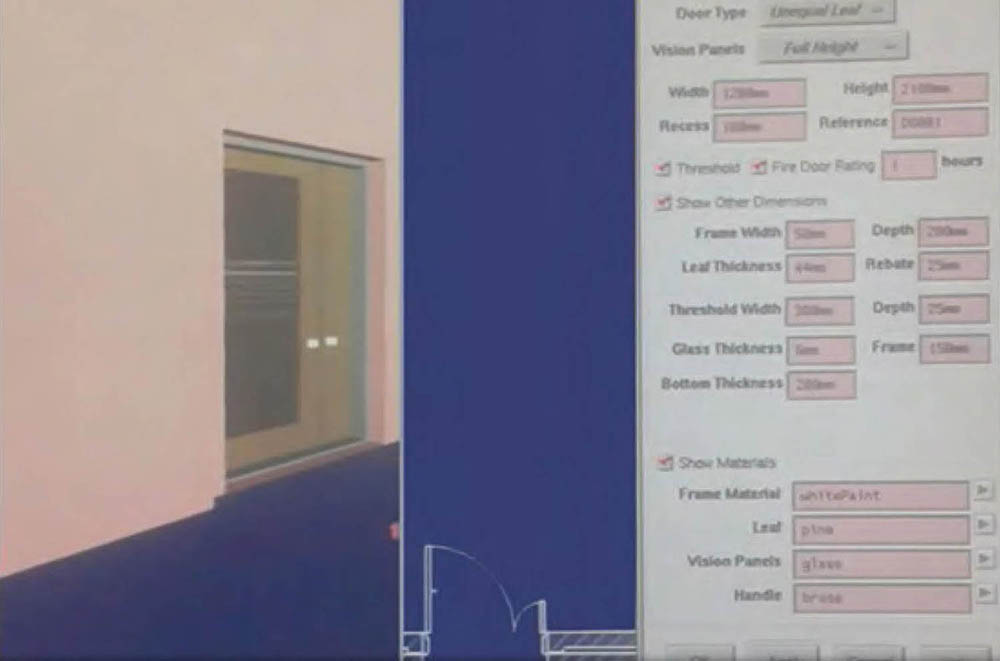We don’t hear much today about Rucaps or Sonata or Reflex – but all three systems played a fundamental role in the development of modern BIM and were largely driven by one man, Dr Jonathan Ingram
There are only a few individuals from the field of BIM who can boast of international acclaim that extends beyond the BIM niche. These individuals are most often recognised for their remarkable efforts in transforming the construction industry, through the invention of ground-breaking technologies. Dr Jonathan Ingram is one such person.
In 2016, Dr Ingram was awarded the prestigious international award, the Prince Philip Gold Medal. This prize is only bestowed occasionally, to individuals who are deemed to have made exceptional contributions to the field of engineering. In Ingram’s case, this involved working on 3D technologies way back in 1986, at a time when the industry was still in awe of 2D AutoCAD, first released just three years earlier.
Unlike most inventors toiling in basements or garages, Ingram chose an attic for his workplace, where his passion for computational design nudged him into a hermit-like lifestyle. Prior to this, he was employed at GMW Computers, where he worked on the CAD application Rucaps, a recognised forerunner of BIM applications.
At this time, the cornerstones for 3D CAD programmes had already been extensively developed and conceptualised during the 1970s and 1980s, in applications such as Rucaps, as well as BDS, GDS, ARK2 and Gable CAD Systems. In fact, the theoretical concepts of what we have come to associate with modern BIM practices had been laid out by the father of BIM, Charles (Chuck) Eastman, in the Building Description System (BDS) software in 1974, almost a decade before the public release of 2D AutoCAD.
But while these applications all represented ground-breaking advances in CAD, none of them qualified as BIM. Rucaps, on which Ingram worked at GMW Computers, was primarily based on the ‘21/2 D’ concept originally proposed in BDS. This refers to the concept of 2D plan, section and elevation views being attached to individual objects to show detailed representations of the object in different perspectives. Rucaps sought to innovate the 21/2 D concept by adding additional 3D representations, an idea proposed by Ingram.
At the time, limitations in computing power required Rucaps to be split into more than 30 individual modules and programmes. Working mainly on his own, Ingram successfully built a bolt-on module for Rucaps that allowed 3D models to be generated from the 2D objects. However, these objects were neither parametric, intelligent nor did they contain any metadata — features that later came to define BIM objects.
While engaged on the Rucaps development, Ingram began envisioning the concept of a single federated model, with integrated parametrics, coordinated 2D and 3D views, clash-detection, construction sequencing and rendering. In the end, his obsession with the concept drove him to quit his job, in order to pursue his own vision.
As a young man of 24, Ingram was able to secure a bank loan that gave him sufficient leverage to purchase a desktop workstation, placed right in the middle of his attic sanctuary. After two years of hard work, Sonata emerged in 1986, just one year before the first release of Archicad. Sonata included all of Ingram’s envisioned features and sent shockwaves through the industry. While there is still some public debate on the matter, it was arguably the world’s first true BIMcapable application — an innovation recognised by both the Prince Philip Award and an Innovation Award from the British Computer Society.
Sonata’s contribution
Sonata was such a robust application that it was still in use 35 years later at major customers in the UK. Unlike line-based 3D CAD, it introduced early definitions of parametric solid modelling and objectoriented design, where individual object categories would adjust differently depending on their relation and interaction with other object categories.
One example is how windows and doors automatically embedded into walls and generated the associated details. Through Sonata’s object-oriented design approach, it was possible to rapidly generate construction plans, sections and 3D perspectives, with design changes automatically updating on all views. Additionally, object-oriented design allowed for both quantity take-off and construction sequencing to be achieved. Sonata even had its own in-built rendering engine — an area of particular interest to Ingram, who wrote his PhD thesis on that subject.
At first glance, the features and workflows of Sonata show a striking resemblance to modern building modelling applications such as Autodesk Revit, despite the fact that Revit was first released some 15 years later. According to Ingram, he came close to an acquisition agreement with Autodesk in 1987. This fell through at the very last minute, as news of the Black Monday historic financial crash broke just as the deal was about to be signed.
Back in the attic, Sonata underwent years of development, evolving into the more complete and user-friendly application Reflex. This was sold to PTC in 1996, in a deal that also saw Ingram become CTO at the acquiring company. At the time, PTC was perhaps best known for its Pro/Engineer application, which later evolved into Creo. This came to enjoy such a dominant market share in mechanical engineering that PTC resolved to expand into the construction market in order to maintain growth.
The mid-1990s was a defining age in the development of BIM. It was a time when the largest players in the industry orchestrated a series of major software acquisitions to safeguard their market dominance. According to Ingram, this was the main driver of PTC’s $30 million acquisition of Reflex — but even with Reflex and Ingram on its side, PTC struggled to make much impact in the construction sector and the strategy was sidelined.
Just two years after the acquisition of Reflex, two PTC employees left to found their own company, based on the development of a building modelling application called Revit. According to Ingram, they carried out their work with access to a non-exclusive licence of Reflex, initially offering Ingram a role in their endeavour. But after more than a decade of intense software development, he felt overwhelmed and burnt out, he says. Embarking on yet another adventure of this kind simply felt too much. The rest, as they say, is history.
Reflex and Revit shared a myriad of features — so much so that it is fairly clear where the Revit team found much of its inspiration. That said, the 1990s were a time of fierce competition between large software rivals, all drawing on each others’ ideas, in their battle to dominate the new and hugely lucrative 3D domain. Some failed. Some were acquired. Some succeeded. But Revit excelled, thanks to the introduction of an ingenious feature: the family editor.
The family editor revolutionsed objectoriented design, enabling professionals to easily create, manipulate and schedule parametric objects in a simple and consistent way. It made reusable object libraries easy to generate and share across projects. The consistency in the parametric structure of these objects made it possible to perform various types of analysis based on object metadata .In other words, the family editor feature came to capitalise the ‘I’ in BIM, making rapid design iterations possible.
Hidden history Given this illustrious background, why have so few people today heard of Sonata, Reflex, or Rucaps? The answer may be multi-faceted, but it is not particularly complicated.
Today, the benefits of BIM remain under debate across the industry. Architects may have pushed for the transition, but clients, contractors and consultants have been slower to follow and more hesitant to adapt to new practices. In short, it has taken decades for the industry to reach its current level of BIM maturity.
For many practices, it has been an undisputably bumpy road to success. Even today, maturity levels vary vastly from country to country and from company to company. Back in the 1980s, this situation was much more pronounced, with only a small percentage of professionals familiar with computers and software expertise a rare and expensive skill.
In addition, the licensing costs associated with pre-1990 building modelling applications like Catia, Archicad and Sonata were steep. These programmes required very expensive desktop workstations to run on.
AutoCAD, on the other hand, was sufficiently light to run on IBM’s first PC, which sold at an affordable price and was thus more widely accessible. And, more obviously, AutoCAD was easier for the industry to adapt to than the 3D CAD programmes of the time, as it did not impose any radical changes on established workflows.
Fast-forward to today, and the same debate between 3D versus 2D still rages, despite most of the industry having already realised the benefits of 3D. In the mid-1990s, when affordable PCs became sufficiently powerful to run 3D building modelling applications, the big software companies had enough momentum to take on the competition with full force.
In a sense, then, Sonata was an application ahead of its time. It was launched to a market that simply wasn’t ready for it, in terms of hardware resources and skills. And, at the same time, BIM workflows, guidelines and industry standards had yet to be formulated at an industry level. Once the market finally caught up, so had the competition. Reflex entered the battle with too little momentum to lead the shift to BIM, and was swallowed up before it ever got a chance to gain a foothold.
All that said, Sonata and Reflex still managed to attract a worldwide user base, particularly in China and the UK — but as is often the case, they have often been left out of the historic spotlight, while attention has been lavished on their more successful rivals.
Either way, the pioneering innovations and legacy of Dr Jonathan Ingram, which played such a defining role in the history of BIM, are indisputable. For those interested in learning more about his story, Ingram’s new book Understanding BIM is a recommended read. And the next time anybody refers to BIM as a new ‘technology’, readers can confidently inform them that, in fact, BIM has existed and matured alongside CAD for more than 35 years.
This article, first published in Building Smart Korea, Autumn 2021 (Vol. 24) edition, was written by Kasper Miller, an editor and researcher at the publication and a Certified Architectural Technologist. Miller previously worked as Head of BIM at a Dublin-based architectural practice, leading the firm’s transition to Revit, training 40 employees and supporting the development of around 20 medium-to-large projects.








